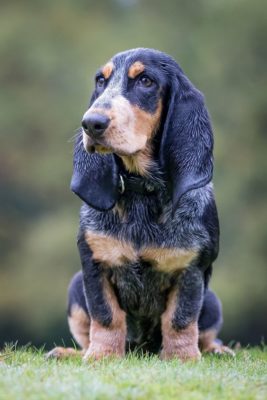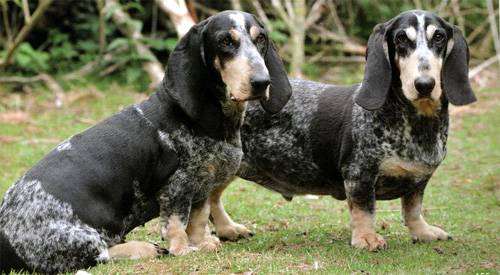Basset Bleu de Gascogne

There is an opinion that the Basset Bleu de Gascogne is a lazybones, but it is not so. The breed is very industrious, nimble, and focused on its assigned duties. A cheerful and loyal dog tries to please the owner and his family members in everything. Good with children and other dogs and even cats, ready to play with anyone friendly with her.
Table of Contents
Breed Information
| Another Name | Blue Gascony Basset, Bleus de Gascogne |
| Origin | France |
| Height | Males 34-38 cm Females 30-35 cm |
| Weight | 16-20 kg |
| Fur | Short |
| Color | Black and white in a mottled pattern |
| Lifespan | 10-12 years |
| FCI Classification | Scent hounds and related breeds |
| Group | Hunting dogs, apartment dogs |
| Price | From $900 |
Breed Photos
Origin History
The history of the Basset Bleu de Gascogne breed’s emergence is shrouded in mystery and heated controversy. In the fourteenth century in southwestern France’s Gascony region, a large Gascon hound circled the breeder Alain Bourbon. The bitch secretly had an affair with a Saintonge Basset. As a result of their love, mutants were born – stunted, short-legged puppies. Alain Bourbon was not confused and pretended that he was trying to create a new breed of basset dog for mink hunting small game in this way.
In 1991, the Fédération Cynologique Internationale officially recognized the breed. Today the Basset Bleu de Gascogne is one of the four blue Gascon hounds that managed to preserve its existence and not disappear from the face of the earth. From being a hunting dog, it has quietly reclassified itself as an indoor dog. It is often used more as a companion than an active helper in hunting hares. The breed is reviving its former popularity, and today it can be found outside France.
Appearance
The Basset Bleu de Gascogne is a stunted dog with short and fat legs. The short hound with a long back is rather heavy and can weigh more than 20 kg. But this does not prevent it from moving quickly and nimbly. Long muzzle with dark and sad eyes; this effect is created because of the sagging lower eyelid. Thin and floppy ears of the same length as the muzzle, placed below the eyes’ level. Many people think that Basset’s unusual coat is blue. It is black with white in a mottled pattern. Colored “sparks” are located on the dog’s muzzle and cheeks above his eyes and on the inside of his ears, as well as on his paws. The long tail is kept in an upright saber-shaped position almost always.
Character
There is an opinion that the Basset Bleu de Gascogne is a lazybones, but it is not so. The breed is very industrious, nimble, and focused on its assigned duties. A cheerful and loyal dog tries to please the owner and his family members in everything. Good with children and other dogs and even cats, ready to play with anyone friendly with her. An intelligent dog easily gets along in any environment. Brave and curious enough, she is easy to control, but with the right approach and early socialization. Stubbornness and willfulness, and a tendency to escape can be eradicated by timely education and training.
Care
The Basset Bleu de Gascogne lives well in an apartment. This southern dog loves the heat and can’t stand the cold. On winter walks, it’s worth stocking up on warm clothes for the dog; without full ammunition, it won’t go out on the street! He doesn’t need long walks; he determines his activity level by himself.
Unfortunately, the Basset Bleu de Gascogne is not a hypoallergenic dog; its short coat sheds seasonally. Its fine hair falls out and floats in the air if it is not carefully groomed. A smooth brush or a special glove can be used to help your dog get rid of dead hairs during intense shedding. You can apply a special conditioner to the coat to keep it shiny and fresh. The dog itself smells quite unpleasant and is prone to skin infections. Before buying dog grooming products, consult a specialist. Clean your dog’s ears weekly to prevent infections and inflammation.
The Basset Bleu de Gascogne is a small dog with a brutal appetite and can easily become overweight. Watch your dog’s diet and nutrition if you don’t want to turn him into an oblong ball.
Training
If you plan to use the Basset Bleu de Gascogne for its intended purpose, you should enlist the help of experts. A newcomer to dog breeding may not handle the proud temperament and stubbornness of the pet. The main key to success in training a basset is reasonable persistence and respect. With its clumsy behavior, the breed can make anyone laugh. Active walks, teaching the simplest commands, and treating with yummy treats – it’s enough for Basset Bleu de Gascogne’s happiness.
Common Diseases
The owner of a Basset Bleu de Gascogne will be a regular visitor to the veterinary clinic. Different sorenesses can come out of the pet. A common problem with dogs with floppy ears is the inadequate ventilation of the ear canal, leading to inflammation and complicating its course. Long floppy ears produce a lot of wax in a poorly ventilated, humid, and warm environment ideal for bacterial growth. Regular cleaning is recommended to prevent and detect such problems.
Bassets are prone to joint disease-it’s also a common ailment among active dogs. Short, often curved, legs put pressure on the joints, leading to the early development of arthritis in dogs. It can be perceived as stiffness after lying down or unwillingness to exercise and should be addressed with medication or supplements under veterinary guidance. A distinctive characteristic of the Basset Bleu de Gascogne is that this hardy hound does not tolerate cold weather conditions well in the heat.
Nutrition
The Basset Bleu de Gascogne is prone to obesity because it loves to eat. The diet must be approached wisely. He needs a balanced diet that includes meat and vegetable dishes, cereals, bread, and healthy supplements. Give preference to lean meats – beef, lamb, or chicken. From vegetables – potatoes, carrots, cabbage can be prepared thick soups in meat broth.
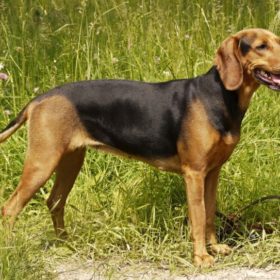 Serbian Hound
Serbian Hound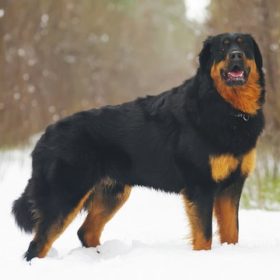 Buryat-Mongolian Wolfhound
Buryat-Mongolian Wolfhound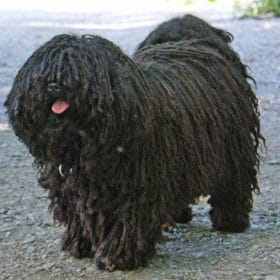 Puli
Puli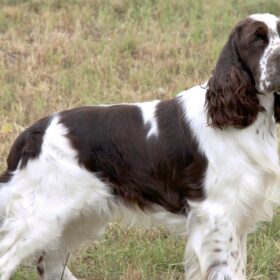 English Springer Spaniel
English Springer Spaniel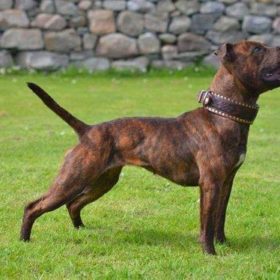 Staffordshire Bull Terrier
Staffordshire Bull Terrier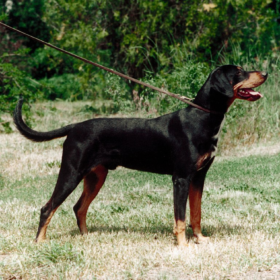 Transylvanian Hound
Transylvanian Hound
